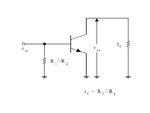Terminator3
Advanced Member level 3
Assuming high frequency BJT (10GHz), where all biasing is done through high impedance thin lines with quarterwave stubs.
what would be equivalent circuit? R1,R2,Rc,Re only loaded by DC.
http://ecetutorials.com/analog-elec...tabilization-biasing-circuitsthermal-runaway/
Should i consider something like Rc=50 Ohm?
what would be equivalent circuit? R1,R2,Rc,Re only loaded by DC.
http://ecetutorials.com/analog-elec...tabilization-biasing-circuitsthermal-runaway/
Should i consider something like Rc=50 Ohm?

